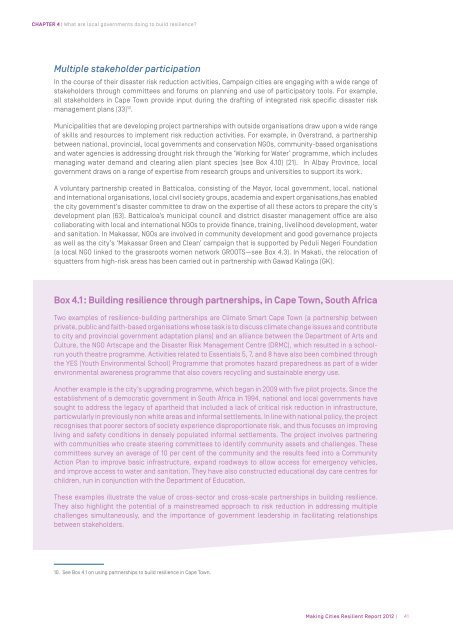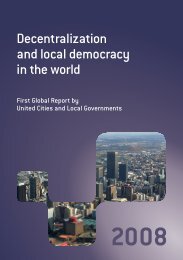Making Cities Resilient Report 2012
Making Cities Resilient Report 2012
Making Cities Resilient Report 2012
Create successful ePaper yourself
Turn your PDF publications into a flip-book with our unique Google optimized e-Paper software.
CHAPTER 4 | What are local governments doing to build resilience<br />
Multiple stakeholder participation<br />
In the course of their disaster risk reduction activities, Campaign cities are engaging with a wide range of<br />
stakeholders through committees and forums on planning and use of participatory tools. For example,<br />
all stakeholders in Cape Town provide input during the drafting of integrated risk‐specific disaster risk<br />
management plans (33) 10 .<br />
Municipalities that are developing project partnerships with outside organisations draw upon a wide range<br />
of skills and resources to implement risk reduction activities. For example, in Overstrand, a partnership<br />
between national, provincial, local governments and conservation NGOs, community-based organisations<br />
and water agencies is addressing drought risk through the ‘Working for Water’ programme, which includes<br />
managing water demand and clearing alien plant species (see Box 4.10) (21). In Albay Province, local<br />
government draws on a range of expertise from research groups and universities to support its work.<br />
A voluntary partnership created in Batticaloa, consisting of the Mayor, local government, local, national<br />
and international organisations, local civil society groups, academia and expert organisations,has enabled<br />
the city government’s disaster committee to draw on the expertise of all these actors to prepare the city’s<br />
development plan (63). Batticaloa’s municipal council and district disaster management office are also<br />
collaborating with local and international NGOs to provide finance, training, livelihood development, water<br />
and sanitation. In Makassar, NGOs are involved in community development and good governance projects<br />
as well as the city’s ‘Makassar Green and Clean’ campaign that is supported by Peduli Negeri Foundation<br />
(a local NGO linked to the grassroots women network GROOTS—see Box 4.3). In Makati, the relocation of<br />
squatters from high-risk areas has been carried out in partnership with Gawad Kalinga (GK).<br />
Box 4.1 : Building resilience through partnerships, in Cape Town, South Africa<br />
Two examples of resilience-building partnerships are Climate Smart Cape Town (a partnership between<br />
private, public and faith-based organisations whose task is to discuss climate change issues and contribute<br />
to city and provincial government adaptation plans) and an alliance between the Department of Arts and<br />
Culture, the NGO Artscape and the Disaster Risk Management Centre (DRMC), which resulted in a schoolrun<br />
youth theatre programme. Activities related to Essentials 5, 7, and 8 have also been combined through<br />
the YES (Youth Environmental School) Programme that promotes hazard preparedness as part of a wider<br />
environmental awareness programme that also covers recycling and sustainable energy use.<br />
Another example is the city’s upgrading programme, which began in 2009 with five pilot projects. Since the<br />
establishment of a democratic government in South Africa in 1994, national and local governments have<br />
sought to address the legacy of apartheid that included a lack of critical risk reduction in infrastructure,<br />
particwularly in previously non‐white areas and informal settlements. In line with national policy, the project<br />
recognises that poorer sectors of society experience disproportionate risk, and thus focuses on improving<br />
living and safety conditions in densely populated informal settlements. The project involves partnering<br />
with communities who create steering committees to identify community assets and challenges. These<br />
committees survey an average of 10 per cent of the community and the results feed into a Community<br />
Action Plan to improve basic infrastructure, expand roadways to allow access for emergency vehicles,<br />
and improve access to water and sanitation. They have also constructed educational day care centres for<br />
children, run in conjunction with the Department of Education.<br />
These examples illustrate the value of cross-sector and cross-scale partnerships in building resilience.<br />
They also highlight the potential of a mainstreamed approach to risk reduction in addressing multiple<br />
challenges simultaneously, and the importance of government leadership in facilitating relationships<br />
between stakeholders.<br />
10. See Box 4.1 on using partnerships to build resilience in Cape Town.<br />
<strong>Making</strong> <strong>Cities</strong> <strong>Resilient</strong> <strong>Report</strong> <strong>2012</strong> | 41

















